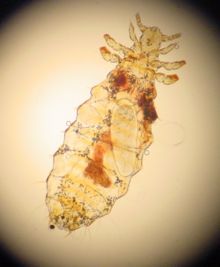Animal lice
| Animal lice | ||||||||||||
|---|---|---|---|---|---|---|---|---|---|---|---|---|

Head louse ( Pediculus humanus capitis ) |
||||||||||||
| Systematics | ||||||||||||
|
||||||||||||
| Scientific name | ||||||||||||
| Phthiraptera | ||||||||||||
| Haeckel , 1896 | ||||||||||||
| Submissions | ||||||||||||
|
The animal lice (Phthiraptera), also known as Lauskerfe or Läuslinge , are a parasitic living insect - order within the new winged birds (Neoptera). About 650 to 1000 of the 3500 species are common in Central Europe, they are usually 1 to 6 mm in size. The animals of the genus Laemobothrium reach a total length of 11 mm.
description
The body of the animal lice is usually very flattened, the head usually protruding. As a rule, the animals have stinging-sucking mouthparts , but especially in the Mallophaga they are also biting. The individual segments of the chest ( thorax ) are fused and do not have wings , the relatively short legs are equipped with clamp mechanisms so that the animals can hold on to the host .
Way of life
All animal lice live as ectoparasites on birds ( feather lice ) or mammals ( real animal lice and hair lice ). They thus represent the only main group of insects (order) in which all members are permanent parasites of birds or mammals. Most species can be found more or less specifically on one host, and several species often populate the same host. Without this host, they are usually only viable for a few days. The transmission usually takes place with direct body contact or via the nest, in the case of clothes louse also via clothing.
ancestry
Contrary to the original doctrine, which is based on a single ancestor of today's animal lice species, an international research group led by Kevin Johnson was able to prove the descent from two different ancestors. Representatives of the parasitic animal lice, despite their great morphological similarity, developed independently of each other twice in the course of evolution , once as the parent form of the Amblycera and once as the parent form of all other animal lice. According to the scientists, the great correspondence of the parasitic body characteristics is the result of adaptation to the host animal, but not a sign of the close relationship between the animals (see also: convergence ).
Systematics
Four taxa are distinguished within the animal lice , which can mainly be identified using the mouthparts. Commonly, the Amblycera and the Ischnocera are summarized in a taxon called Mallophaga (hair lice and feather lice):
Amblycera
The animals of the taxon Amblycera feed mainly on substances containing keratin such as hair , skin flakes and feathers . They live in the fur of mammals or in the plumage of birds. Important representatives of this group are Gliricola porcelli , which was introduced from South America with the guinea pigs and parasitizes on them, as well as the largest species of animal lice Laemobothrium atrum , which lives in the plumage of the coot .
Ischnocera
The Ischnocera feed as the Amblycera keratin substances, and also come in birds and mammals before. This group includes the blackbird ( Philopterus merulae ), the dog furling ( Trichodectes canis ), which transmits the cucumber seed tapeworm ( Dipylidium caninum ) in dogs , and the cat furling ( Felicola subrostratus ).
Rhynchophthirina
In the Rhynchophthirina , the front head area is elongated like a trunk and drawn out forward. The elephant louse genus ( Haematomyzus ) shares this trait with its hosts, the elephants and warthogs . The Rhynchophthirina include only the family Haematomyzidae with the only genus Haematomyzus (with three species).
Anoplura Real animal lice
The real animal lice are blood-sucking insects that live on mammals . They have no wings and are one to six millimeters in size. They stick their eggs, the so-called nits , to the host's hair. Lice are sometimes disease vectors. Around 400 species of lice are known, around 20 occur in Central Europe.
This group includes the best-known representatives of the lice, the human lice (Pediculidae) such as the pubic louse ( Pthirus pubis ) and the two subspecies of the human louse , the body louse ( Pediculus humanus humanus ) and the head louse ( Pediculus humanus capitis ). There are also many other species, such as the seal louse ( Echinophthirius horridus ) that lives on seals and is accordingly salt water tolerant, and the pig louse ( Haematopinus suis ) on domestic pigs .
Web links
Individual evidence
- ^ A b Johnson, KP et al .: Multiple origins of parasitism in lice . In: Proc Biol Sci . 271, No. 1550, 2004, pp. 1771-1776. PMID 15315891 .
